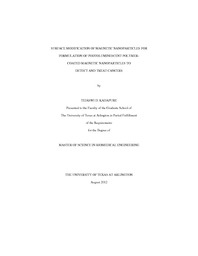
ATTENTION: The works hosted here are being migrated to a new repository that will consolidate resources, improve discoverability, and better show UTA's research impact on the global community. We will update authors as the migration progresses. Please see MavMatrix for more information.
Show simple item record
| dc.contributor.author | Kadapure, Tejaswi Dhanpal | en_US |
| dc.date.accessioned | 2013-03-20T19:14:18Z | |
| dc.date.available | 2013-03-20T19:14:18Z | |
| dc.date.issued | 2013-03-20 | |
| dc.date.submitted | January 2012 | en_US |
| dc.identifier.other | DISS-11825 | en_US |
| dc.identifier.uri | http://hdl.handle.net/10106/11669 | |
| dc.description.abstract | Cancer has been one of the leading causes of death worldwide that necessitates the development of theranostic systems for effective cancer management. Previously, we developed biodegradable-photoluminescent polymer coated magnetic nanoparticles (BPLP-MNPs) as a theranostic system for cancer management. These BPLP-MNPs were highly stable with excellent biocompatibility and consisted of magnetic targeting and imaging capabilities. However, these particles experienced reduced fluorescence due to the presence of dark/blackness of MNPs, which absorbs excited/emitted light. Therefore, it was hypothesized that surface modification on MNPs can overcome this limitation and enhance fluorescence for BPLP-MNPs.The goal of this research was therefore to employ various surface coatings such as silane (Si), hydroxypatite (HA), or Si with azide on MNPs prior to formulation of BPLP-MNPs and investigate if the surface modification of MNPs would improve their properties, particularly the fluorescent properties. Modified MNPs were used to formulate BPLP-MNPs by either standard emulsion or click chemistry techniques. The obtained BPLP-coated surface modified MNPs (BSM-MNPs) with a diameter range of 200-350 nm were stable and biocompatible. Additionally, Fourier Transform Infra-Red (FTIR) spectra analysis and Transmission Electron Microscopy (TEM) confirmed the chemical and morphological structures of BSM-MNPs. The particles possessed superparamagnetic properties and provided excellent contrast for magnetic resonance imaging (MRI). In addition, all BSM-MNPs had excellent fluorescence intensity compared to that of BPLP-MNPs. The further analysis of fluorescence intensity <italics>in vitro<italics> and <italics>in vivo<italics> optical imaging of the particles indicated that MNP-HA-BPLP particles exhibited best fluorescence amongst BSM-MNPs. MNP-HA-BPLP particles were further used for therapeutic applications. To study the potential use of MNP-HA-BPLP nanoparticles as a drug carrier, anti-cancer drugs such as Paclitaxel and Docetaxel were used as drug models. MNP-HA-BPLP particles could deliver 80% of loaded drug over a period of 21 days and were uptaken by cancer cells in a dose-dependent manner, Furthermore, MNP-HA-BPLP-drug loaded particles effectively reduced cancer cell growth, supporting their use for cancer treatment. In conclusion, MNP-HA-BPLP forms an efficient theranostic system with excellent dual imaging and therapeutic capabilities. Future studies include extensive work on <italics>in vivo<italics> therapeutic efficacy of MNP-HA-BPLP particles. | en_US |
| dc.description.sponsorship | Nguyen, Kytai Truong | en_US |
| dc.language.iso | en | en_US |
| dc.publisher | Biomedical Engineering | en_US |
| dc.title | Surface Modification Of Magnetic Nanoparticles For Formulation Of Photoluminescent Polymer-coated Magnetic Nanoparticles To Detect And Treat Cancers | en_US |
| dc.type | M.S. | en_US |
| dc.contributor.committeeChair | Nguyen, Kytai Truong | en_US |
| dc.degree.department | Biomedical Engineering | en_US |
| dc.degree.discipline | Biomedical Engineering | en_US |
| dc.degree.grantor | University of Texas at Arlington | en_US |
| dc.degree.level | masters | en_US |
| dc.degree.name | M.S. | en_US |
Files in this item
- Name:
- Kadapure_uta_2502M_11825.pdf
- Size:
- 820.9Kb
- Format:
- PDF
This item appears in the following Collection(s)
Show simple item record


